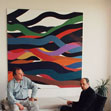texts about zs
“The difference between concrete and abstract art rests in the fact that in abstract art the contents of pictures are dependent on the images of nature, whereas in concrete art the contents of pictures are generated independently of the images of nature. An example of this is provided by an extreme case in painting: There is a red point on white canvas. The red point could have originated in two different ways: either, it could have represented the sun rising in mist, an instance in which it should be regarded as an abstraction; or otherwise, it could be a red point which expresses an artistic reality solely by its relationship to a surface. That latter case relates to the concretion of an abstract idea, and consequently, to concrete art.”
Max Bill
The line paintings of Zdeněk Sýkora are rooted in the Czech neo-constructivist art of the 1960x. The tendency towards the informal expression then prevailing in Bohemia´s progressive artistic circles, soon provoked the emergence of a constructivist antithesis, with Zdeněk Sýkora and several of his friends as protagonists.
Initially a landscape painter, by the early nineteen-sixties – influenced primarily by Matisse and Poliakoff – the reached a stage at which he produced a cycle of highly generalizing paintings, titled Gardens, in which he manifested, for the last time with such immediacy, his affection for nature and its sensual perception. Accordingly, his creative path to the structures of the elements (the first of which, Gray, dates from early 1963) le (in the sense of Max Bill´s definitions) through abstraction. He himself refers to that phase as to a search for colour. This quest gradually yielded increasingly planary compositions which in their turn involved ever simpler and more geometrical forms. The surface of a painting now required new organization, something it was assigned in the form of a grid, i.e. a topologically organized field of (only seemingly) recurrent elements. Sýkora soon discovered that the way in which this illusory recurrence was performed, represented an analogy to a computer program, he therefore involved a computer in the process, assigning it merely the task of an instrument capable of completely executing the author´s project: just that and nothing more.
Now no more did this imply any kind of abstraction. Without knowing it, and without making an effort in that direction, Sýkora at that point entered the domain of concrete art as it was defined (in contrast to abstraction) by Max Bill. This, however, does not mean that Zdeněk Sýkora would have let himself be carried away by a collective program or school of thinking: Typically of him, he would obstinately follow a path of his own. If, then, as a painter he had been plunged into the sphere of concrete expression quite spontaneously, by the mere fact of pursuing a constant dialogue with his colours and forms, and in the process “solving” one “problem” after another, now his path acquired a firm purpose. He embarked on a minute investigation of elementary structures, eventually to tackle the so-called macrostructure, i.e. something very much like large details of structures of circular elements whose organization is instrumental in generating a structure of a system (at that time, in 1969, this concerned a structure made up of circular and semicircular elements), but rather by the line which is drawn by the contours of the elements undergoing the process of being organized.
The year 1973 witnessed the emergence of the first line painting. Each line in the picture has a life of its own, with the place of its birth, the directions of its movement and the number of steps determining the duration of its life being all governed by chance, by the cast of the die. While in the structures of geometrical elements the cast of the die was instrumental in determining an inorganic system, here it defines an organic, accidental course of a curve.
Both Sýkora´s early output with its focus on elementary structures, and his line creations of the last two decades (which are no longer dependent on a grid and which show absolute freedom in terms of the orientation, colour, shape, thickness and length of line), are invariably homologous with the reality of both nature and human society. Accordingly, Sýkora´s work can be regarded as models or allegories at which he has arrived solely through concern with autonomous and entirely introspect problems of his own art, problems arising in the course of the ongoing dialogue between the artist and his work.
Consequently, Zdeněk Sýkora´s art gives a unique proof of an inner accord, a harmony existing between the logic of an artistic statement (and in a broader sense, of a whole trend in modern art), and the logic of modern science: In it, one observes a juncture, perhaps even a convergence, of two domains of human endeavour which have so far seemed to involve quite independently of each other and which have reached this meeting point by their own autonomous ways. This particular quality of Sýkora´s work clearly empraces both the promises and the risks inherent in each of these two domains.
Translation: Jutta Horton


